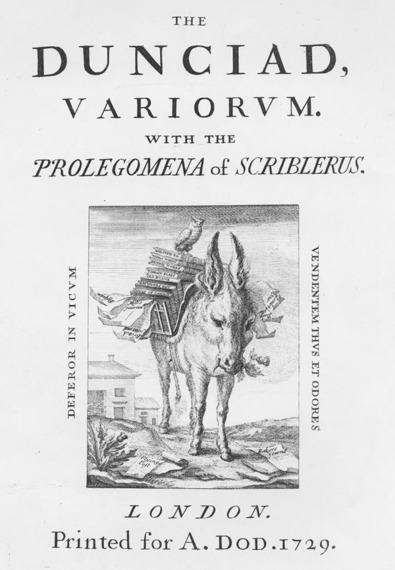
Verse 20:
19 O Thou! whatever title please thine ear,
20 Dean, Drapier, Bickerstaff, or Gulliver!
The first verse is what we call typical in that it is the normal iambic pentameter verse:
19 Ŏ Thōu! | whătēv | ĕr tī | tlĕ plēase | thĭne ēar
A wonderful verse with the alignment of both metrical accent and speech stress.
The companion verse is not so clearcut. There is often difficulty when using a person’s name in verses, even more so when several names are used. In this instance, the list of names has been expertly done using a dactyl for Bickerstaff:
20 Dĕan, Drāp | ĭēr | Bīckĕrstăff | ŏr Gūl |lĭvēr
The quickness of the dactyl allows allows all names to be read read with little trouble. However there is yet a more appropriate interpretation of the verse:
20 ~ Dēan | Drāpĭĕr | Bīckĕrstăff | ° ōr | Gūllĭveͯr
This is an interest construction, and very much more to the liking and normal reading of the verse. Generally, when mentioning names, we are most likely to emphasize them. Most, if not all English name will have the speech stress and metrical accent on the first syllable. Thus we would be expecting Dean to be emphasized in some way, so we have the clipped foot at the start.
Although not all commas have not been metrically timed, they do allow for the introduction of the dactyl for the other three names. But, there may be some doubt as to whether Gulliver may be cretic to align with the metrical accent of the companion verse. There is no real concern because the outcome is the same.
The only break required, signaled by a comma, is before or. Again we find that this comma is metrically timed in this position being at the end of a consecutive list or at least a pause-foot, whereas it is not in the first or second occurrence. The two consecutive dactyl variations demand the pause before proceeding to the iamb and yet another possible dactyl. Granted people may read the line differently, but I believe that with these metrical accents being aligned with speech stress, we will have the ideal reading.
Verse 37:
37 Hence Bards, like Proteus long in vain ty’d down,
38 Escape in Monsters, and amaze the town.
We can easily dispense with the companion verse (38) because of its iambicity.
38 Ĕscāpe | ĭn Mōn |stĕrs ānd | ămāze | thĕ tōwn
So there is little to see here. The reality is that there is no great confusion with with the first (37) unless you are intent on syllable counting or forcing the full iambic nature upon the verse.
37 Hĕnce Bārds | lĭke Prō |te͝us lōng | ĭn vāin | ty̆’d dōwn
Attempting the series of iambs do pose the question as to the sounding of Proteus. Is it possible to pronounce Proteus as two syllables? If we blur eu, the name may be made to sound like two syllables. However, there is also the difficulty that Proteus is split over two iambs and this would tend to misalign the speech stress and metrical accent.
The better interpretation takes on the construction of four feet, but it may be debatable as to how many metrical accents, and in turn speech stresses actually exist.
37 Hĕnce Bārds | lĭke Prōtĕŭs | lōng ĭn vā̆in | ty̆’d dōwn
The reader may be tempted to place more stress on vain. As a result the fourth foot could be interpreted as cretic, but it is more likely dactyl.
We may question the validity of the four feet, but this is rather pointless because the rhythm does not conflict with that of the companion verse or the following verse. In fact, it is one of those cases where the four feet give the illusion of five due to the presence of two three-syllable feet. The use of, or the this construction may not be as uncommon as we may like to think. However, the cretic will strengthen the illusion of five feet.
Ferrick Gray
July, 2024
Green Iamb Publications
an imprint of
xiv lines
